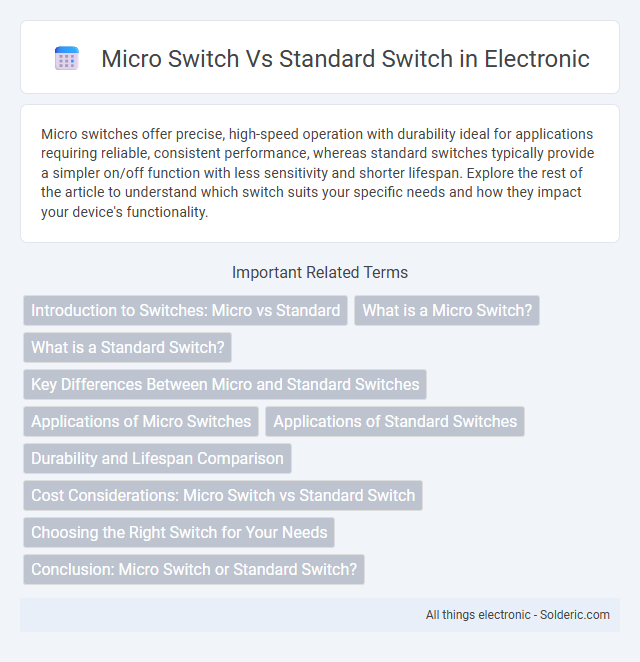Micro switches offer precise, high-speed operation with durability ideal for applications requiring reliable, consistent performance, whereas standard switches typically provide a simpler on/off function with less sensitivity and shorter lifespan. Explore the rest of the article to understand which switch suits your specific needs and how they impact your device's functionality.
Comparison Table
| Feature | Micro Switch | Standard Switch |
|---|---|---|
| Definition | Small, precision switch activated by minimal physical force. | General purpose switch for basic on/off functions. |
| Size | Compact, miniature design. | Larger, conventional size. |
| Actuation Force | Low force, typically 50-150 grams. | Medium to high force, varies widely. |
| Durability | High cycle life (up to 10 million operations). | Moderate cycle life, less than micro switches. |
| Precision | High accuracy and quick response. | Lower precision and slower actuation. |
| Applications | Industrial machinery, appliances, automotive controls. | Residential lighting, electronics, basic controls. |
| Cost | More expensive due to precision design. | Generally lower cost. |
Introduction to Switches: Micro vs Standard
Micro switches feature a compact design and precise actuation mechanism suited for applications requiring rapid and reliable switching with minimal physical force. Standard switches typically offer a larger size and straightforward operation ideal for general-purpose electrical control and manual toggling. Your choice depends on factors like scalability, sensitivity, and usage environment in industrial or household settings.
What is a Micro Switch?
A micro switch is a compact, highly sensitive electrical switch that operates with minimal physical force, often used in precision devices and safety applications. Unlike standard switches that require more substantial actuation, micro switches feature a snap-action mechanism for rapid response and consistent performance. Your choice of a micro switch ensures reliable durability and accuracy in controlling electrical circuits where space and sensitivity are critical.
What is a Standard Switch?
A Standard Switch is a basic electrical device designed to control the flow of electricity by turning a circuit on or off. It typically features a simple on/off mechanism, commonly used in household lighting and appliances. Your choice between a Standard Switch and a Micro Switch depends on the required precision and application sensitivity.
Key Differences Between Micro and Standard Switches
Micro switches feature a compact design with a fast, precise actuation mechanism suitable for detecting small movements, whereas standard switches are larger and designed for general on/off control. Micro switches typically offer higher sensitivity and durability with mechanical snap-action that ensures reliable performance in industrial and appliance applications. Your selection depends on the required sensitivity, size constraints, and application-specific switching speed.
Applications of Micro Switches
Micro switches, known for their high precision and reliability, are widely used in industrial machinery, automotive systems, and home appliances where rapid and accurate switching is essential. Their ability to handle small movements with consistent repeatability makes them ideal for limit switches, safety interlocks, and control panels. Unlike standard switches, micro switches excel in applications requiring sensitive detection and long-lasting durability under repetitive operations.
Applications of Standard Switches
Standard switches are widely used in residential and commercial lighting systems due to their durability and simplicity. These switches control electrical circuits in appliances, fans, and basic electronic devices, making them ideal for everyday use. Your home or office lighting relies heavily on standard switches for reliable and easy operation.
Durability and Lifespan Comparison
Micro switches typically offer superior durability and longer lifespan compared to standard switches, often rated for millions of cycles due to their robust internal mechanisms. Standard switches generally have a shorter operational life, with typical ratings ranging from tens of thousands to a few hundred thousand cycles. The enhanced durability of micro switches makes them ideal for applications requiring frequent switching and reliability under harsh conditions.
Cost Considerations: Micro Switch vs Standard Switch
Micro switches typically feature compact designs and precise mechanisms, which can result in higher manufacturing costs compared to standard switches. Standard switches often offer more cost-effective solutions for basic on/off applications, making them preferable for budget-sensitive projects. Choosing between micro and standard switches depends on balancing performance requirements with cost constraints in specific applications.
Choosing the Right Switch for Your Needs
Micro switches provide precise and reliable operation with fast response times, making them ideal for applications requiring accurate positioning and frequent switching cycles. Standard switches offer more robust construction suited for general-purpose use with higher current ratings, fitting scenarios where durability and straightforward functionality are priorities. Evaluate your specific application's requirements for sensitivity, load capacity, and switch lifespan to choose the right switch that ensures optimal performance and longevity.
Conclusion: Micro Switch or Standard Switch?
Micro switches offer higher precision and durability, ideal for applications requiring quick, reliable actuation with minimal physical effort. Standard switches, while more cost-effective, tend to have shorter lifespans and less sensitivity, suited for general use where rapid response is less critical. Your choice should depend on the specific requirements of reliability, sensitivity, and operational frequency in your project.
Micro switch vs Standard switch Infographic

 solderic.com
solderic.com